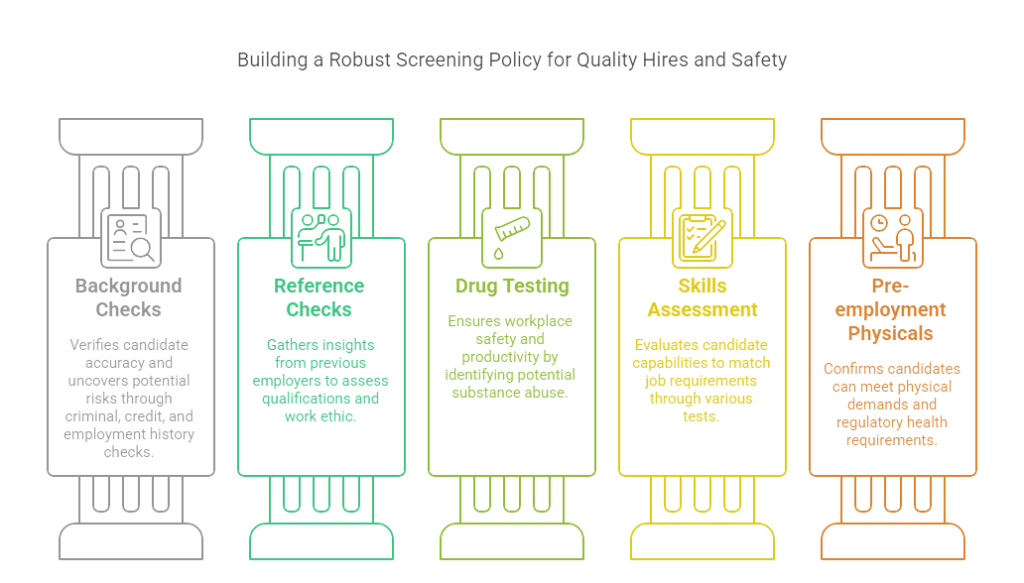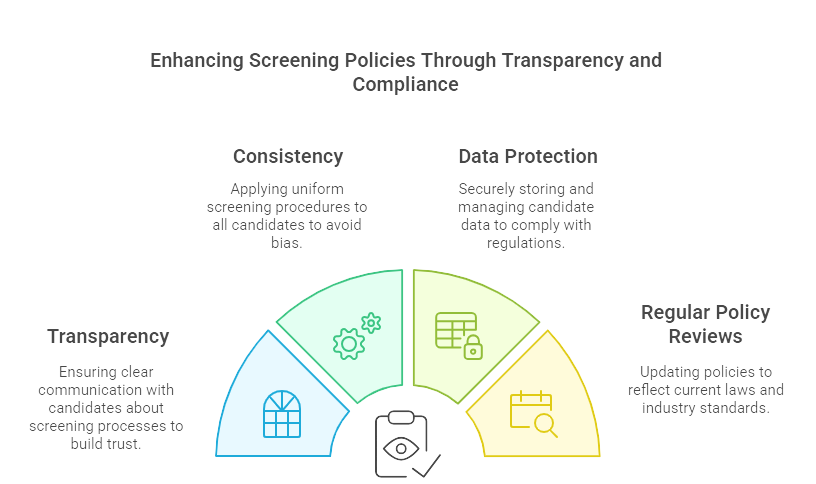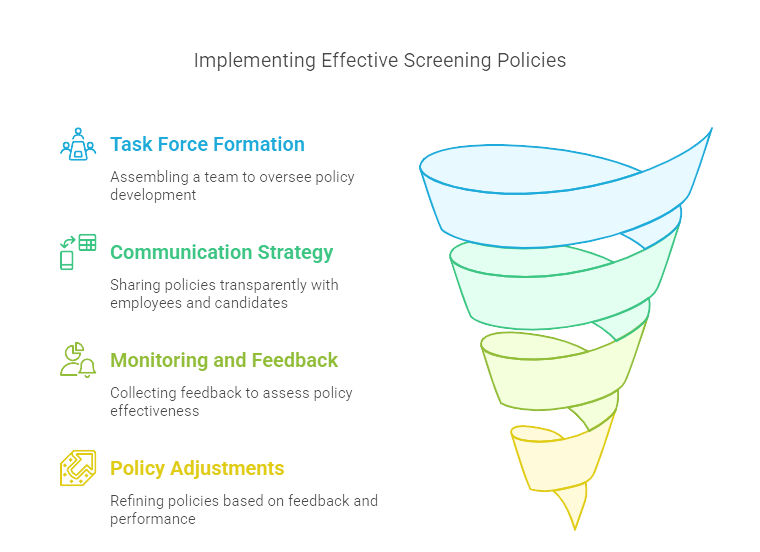In today’s competitive job market, developing robust screening policies and procedures is crucial for businesses of all sizes. Effective screening not only helps in identifying the best candidates but also mitigates risks associated with hiring unqualified or untrustworthy individuals.
This guide serves as a valuable resource for business owners, HR professionals, recruiters, and job seekers, providing insight into crafting and implementing thorough screening policies. From policy development to best practices, this comprehensive guide will help you navigate the complex landscape of hiring.
Key Takeaways
- Robust screening policies are crucial for mitigating risks, ensuring compliance, and improving the quality of hires.
- Key components of comprehensive screening policies include background checks, reference checks, drug testing, skills assessments, and pre-employment physicals.
- Effective implementation of screening policies requires clear objectives, legal compliance, documented procedures, and thorough training for HR personnel.
- Best practices like transparency, consistency, data protection, and regular policy reviews enhance the efficacy and integrity of the screening process.
- Addressing common challenges such as bias, legal issues, and false positives/negatives ensures a fair, accurate, and legally compliant hiring process.
Introduction
In the cutthroat world of today’s job market, having solid screening policies isn’t just a bonus; it’s a necessity. These policies serve as the backbone for any business serious about hiring the right talent. Think about it—negligent hires not only drain resources but can also pose significant risks to the company. Therefore, implementing a strategy to filter through applicants effectively is crucial.
Screening policies encompass various measures like background checks, skills assessments, and even drug testing. These steps ensure you’re not only bringing in competent individuals but also safeguarding your workplace. When done right, these procedures can help mitigate risks, streamline the hiring process, and boost overall company performance by securing top-notch talent.
This article aims to be your go-to guide for developing such comprehensive screening policies. We’ll take you through why these policies are essential, break down their key components, and provide a step-by-step approach to crafting your procedures. By the end, you’ll have a roadmap to enhance your hiring process, ensuring both compliance and quality.

Why Develop Screening Policies and Procedures?
Risk Mitigation
When it comes to hiring, the stakes are high. Poorly conducted screenings can lead to negligent hiring lawsuits, damage a business’s reputation, and create unsafe workplace conditions. Comprehensive screening policies act as a safeguard, helping employers avoid costly legal battles and ensuring that employees contribute positively to the work environment. Think of it as a filter that keeps out elements potentially harmful to your company culture and bottom line.
Quality Hiring
The difference between a good employee and a great one often lies in how thoroughly they’ve been vetted. Effective screening processes ensure that you’re not just filling positions, but strategically bringing in individuals who enhance the team’s overall competence and productivity. A robust policy helps in sifting through a sea of resumes to find candidates who are truly a cut above the rest, making the hiring process more efficient and effective.
Regulatory Compliance
Navigating the labyrinth of federal, state, and industry-specific regulations can be daunting, but it’s essential for any reputable business. Proper screening policies help ensure that you are compliant with these laws, reducing the risk of hefty fines and legal complications. This isn’t just about ticking boxes; it’s about adhering to standards that protect both your organization and your employees. For more details, visit the Department of Labor.
EXPERT INSIGHT: As someone who’s spent time sitting on the other side of interview tables as an employer and had the role of making mission-critical hires, I’ve discovered that good screening practices aren’t gatekeeping—they’re people and potential preservation. I’ve seen firsthand how a thoughtfully designed, equitable, and consistent process prevents costly mistakes and provides top talent with the transparency and respect they need. Screening resumes or running background reports isn’t the issue—it’s an issue about building a culture of trust, transparency, and accountability. When the process of screening is thoughtful and human-focused, we don’t just hire—we build teams that last. – Charm Paz, CHRP
Key Components of a Screening Policy
Background Checks
Background checks are a critical part of any screening policy and can include checks on criminal history, credit reports, and employment history. These checks help verify the accuracy of a candidate’s resume and can reveal red flags that might not surface during an interview. Criminal background checks can uncover past convictions that could indicate risk, while credit checks can provide insight into financial responsibility—valuable for roles that handle money. Employment history checks verify a candidate’s job history, ensuring they are honest about their roles and responsibilities. As a best practice, always inform candidates about the background checks being performed and obtain their consent.
For a more detailed look at common questions related to background checks, you can refer to our internal resource: Common Background Check Questions.
Reference Checks
Reference checks offer additional perspectives on a candidate’s qualifications, reliability, and work ethic. They involve contacting previous employers or professional contacts to verify the information provided by the candidate and gather more nuanced insights into their performance and behavior. When conducting reference checks, be systematic. Prepare questions that focus on the candidate’s past job performance, strengths, areas for improvement, and suitability for the new role. This step can significantly reduce the risk of hiring an underperformer.
Drug Testing
Drug testing helps ensure a safe and productive workplace. While not all organizations require it, drug testing is crucial in industries where safety is paramount, such as transportation, manufacturing, and law enforcement. Implementing drug testing involves outlining clear policies, informing candidates of the requirements, and employing reliable methods for testing. Depending on your industry and location, specific regulations may exist, so always check the relevant guidelines.
Skills Assessment
Skills assessments are instrumental in determining whether a candidate’s capabilities match job requirements. These assessments can range from technical tests for IT roles to writing samples for editorial positions or practical tasks for trade jobs. Implement assessments that closely mirror the daily functions of the position. This gives you an accurate picture of the candidate’s skills and helps the candidate self-evaluate their fit for the role.
Pre-employment Physicals
Pre-employment physicals are necessary in specific industries to ensure candidates can meet the job’s physical demands. These exams can prevent workplace injuries and verify that employees meet regulatory health requirements. Include this step in your screening process if your roles require heavy lifting, prolonged physical activity, or interaction with hazardous materials. Always provide candidates with detailed information on what the physical entails and its necessity.
By incorporating these key components, you’ll build a robust screening policy that enhances the quality of your hires and safeguards your organization’s interests.

Steps to Develop Screening Procedures
Identify Objectives
First things first: know what you’re aiming for. Are you focused on finding top-tier talent? Reducing turnover? Or maybe ensuring workplace safety? Your objectives will shape the entire screening process. Make sure they’re aligned with your organizational goals.
Legal Compliance
Next, you’ll want to cover your legal bases. This means ensuring your policy adheres to all relevant federal, state, and industry-specific laws. It’s not just about avoiding lawsuits; it’s about fostering a fair and transparent screening process. For detailed guidance, you can check out this SHRM Toolkit.
Choose Screening Methods
With your objectives and legal requirements in mind, you can now decide on the most suitable screening methods. Whether it’s background checks, drug tests, or skills assessments, make sure the methods you choose align with your goals and industry standards.
Policy Documentation
Drafting clear, concise documentation is critical. Specify each step of your screening procedures, who is responsible for what, and how the data will be handled. Comprehensive documentation not only guides your HR team but also enhances transparency with candidates.
Training and Implementation
Finally, roll out the training. Your HR personnel need to understand the ins and outs of the new procedures. Conduct training sessions and provide resources to ensure everyone is on the same page. Once everyone is trained, you can implement the policies, monitoring their effectiveness through initial feedback loops.
Each of these steps builds the foundation of a well-rounded screening process that not only helps you identify top talent but also keeps you legally compliant and organizationally consistent.
Best Practices for Screening Policies
Transparency
Being transparent with candidates about the screening processes fosters trust and ensures that applicants understand what to expect. Provide clear explanations of each stage of the screening procedure, including the types of checks performed and the reasons behind them. Transparency not only helps in setting the right expectations but also minimizes anxiety and resentment, leading to a smoother hiring process.
Consistency
Applying screening policies uniformly across all candidates is paramount. Inconsistent application of policies can lead to perceptions of bias and potential legal challenges. Standardize your procedures and ensure that every candidate is subjected to the same level of scrutiny. This consistency helps in building a fair and equitable hiring process, boosting the employer’s reputation and reducing the risk of discriminatory practices.
Data Protection
In an age where data breaches are increasingly common, protecting candidates’ personal information is not optional—it’s necessary. Ensure that all personal data collected during the screening process is stored securely and accessed only by authorized personnel. Adhere to data protection regulations such as GDPR or CCPA, and have clear policies about data retention and deletion. This not only builds trust with your candidates but also protects your organization from potential legal repercussions.
Regular Policy Reviews
Screening policies should be treated as living documents that require regular updates to stay relevant. Periodically review your procedures to ensure they comply with current laws, reflect the latest industry standards, and incorporate emerging best practices. Collect feedback from all stakeholders, including HR personnel and candidates, to identify areas for improvement. Regular reviews help adapt the policies to evolving business needs and regulatory landscapes, ensuring they remain effective and compliant.
Implementing these best practices can significantly enhance the efficacy and integrity of your screening process, helping you attract and retain top talent while safeguarding your organization from potential risks.

Common Challenges and Solutions
When it comes to developing and implementing screening policies, there are several common challenges that organizations frequently face. Here are the key issues and practical solutions to address them.
Bias and Discrimination
One of the most significant challenges in screening processes is the potential for bias and discrimination. Even unintentional biases can skew hiring decisions and lead to unfair treatment of candidates.
Solution: Implement structured and standardized procedures, such as using uniform interview questions and criteria for all candidates. Regularly train hiring personnel on recognizing and mitigating unconscious bias. Tools like blind resume reviews can also help eliminate bias by focusing solely on qualifications and experience.
False Positives/Negatives
Screening processes are not infallible, and errors such as false positives or false negatives can occur. These can lead to hiring unqualified candidates or rejecting qualified ones.
Solution: Use multiple methods of assessment to cross-verify information. For instance, combine background checks with skills assessments and reference checks to get a more complete picture of a candidate’s suitability. Additionally, establish a protocol for investigating discrepancies, allowing candidates to explain or contest the findings.
Legal Issues
Navigating the legal landscape of screening processes can be tricky. Issues such as failing to comply with state and federal regulations can lead to costly legal consequences.
Solution: Stay up-to-date on relevant laws and guidelines. Regularly consult legal experts to ensure your screening policies comply with the latest regulations. Thorough documentation of each step in the screening process can serve as evidence of compliance if any disputes arise.
By addressing these common challenges head-on, organizations can enhance their screening policies, ensuring they are fair, accurate, and legally compliant.
Implementing Screening Policies
Implementing screening policies is a crucial step that can determine the efficacy of your hiring processes. A well-thought-out implementation can ensure that your screening policies are practical, legally compliant, and conducive to attracting the best talent.
Creating a Task Force
To start, form a dedicated committee or task force to oversee the development and implementation of your screening policies. This group should include representatives from HR, compliance, legal, and relevant leadership roles. Their responsibility is to ensure that every aspect of the policy is scrutinized and refined before being put into practice.
Communication Strategy
Once your policies are developed, the next step is to communicate them effectively. Transparently share your screening procedures with all employees, including the rationale behind each step. Clear communication can help minimize resistance and promote understanding among your staff. It’s also essential to inform job candidates about your screening policies early in the process. Make sure they know what to expect and why these steps are necessary.
Monitoring and Feedback
After implementation, it’s vital to continuously monitor the effectiveness of your screening policies. Develop a system for collecting feedback from both HR personnel and candidates. Use this feedback to identify any issues or areas for improvement. Regular audits can help ensure that the policies are not only being followed but are also delivering the intended results.
Adjustments based on real-world performance will make your screening policies more robust and adaptive to evolving industry standards and legal requirements. By implementing these strategies, you set the foundation for a hiring process that is efficient, fair, and legally sound.

Frequently Asked Questions (FAQ)
Still grappling with how to establish fair and reasonable screening policies? You’re not alone. From adhering to difficult regulations to avoiding discriminatory practices and resolving conflicts, there’s a lot to unravel. In the FAQ section that follows, some of the most common questions HR professionals, entrepreneurs, and recruiters grapple with as they work to improve their hiring practices are answered. Whether you’re starting from a blank slate or updating policies you already have, these answers will help you comply, be ethical, and be effective.
What are the legal implications of screening?
Navigating the legal landscape of screening is crucial. Laws vary by jurisdiction but generally include regulations like the Fair Credit Reporting Act (FCRA) in the U.S., which governs background checks, and the Equal Employment Opportunity Commission (EEOC) guidelines, which aim to prevent discriminatory hiring practices. Non-compliance can lead to lawsuits and hefty fines. It’s essential to stay informed about federal, state, and local regulations and to consult legal counsel to ensure your screening processes are lawful.
How can I ensure my screening process is unbiased?
Unbiased screening starts with designing objective, standardized procedures. Use data-driven tools and criteria that focus solely on job-related qualifications. Training HR personnel to recognize and eliminate biases is also crucial. Additionally, employing blind recruitment techniques, where personally identifiable information is removed from applications, can help mitigate unconscious bias. Regular audits of your screening outcomes can further ensure fairness and transparency.
What should I do if a candidate disputes a screening result?
When a candidate disputes a result, it’s important to handle the situation promptly and professionally. First, provide the candidate with the report and explain any adverse findings. Allow them to present any corrections or explanations. You may need to verify the data or consult with the screening agency. Maintaining open communication and documenting the resolution process helps ensure fairness and compliance with legal requirements.
How often should I review and update my screening policies?
Regular reviews of your screening policies are vital to keep them effective and compliant. Aim for an annual review, but also update policies in response to significant legal changes, industry trends, or organizational shifts. Continuous feedback from your HR team and candidates can highlight areas for improvement. Staying proactive in updating your policies will help your organization maintain a fair, lawful, and efficient hiring process.
Conclusion
Comprehensive screening policies are essential for effective and legal hiring practices. By carefully crafting and implementing thorough screening procedures, businesses can mitigate risks, ensure regulatory compliance, and enhance the quality of their hires. Such policies not only protect the organization but also create a safer, more productive work environment.
We urge business owners, HR professionals, and recruiters to regularly review and refine their screening practices. Continuous improvement in this area will contribute to attracting and retaining top talent, ultimately driving the success of the organization.
While developing comprehensive screening policies may require significant effort and meticulous attention to detail, the long-term benefits—including reduced risks, better hires, and enhanced organizational performance—far outweigh the initial investments. Prioritize your screening processes today to build a stronger workforce for tomorrow.

